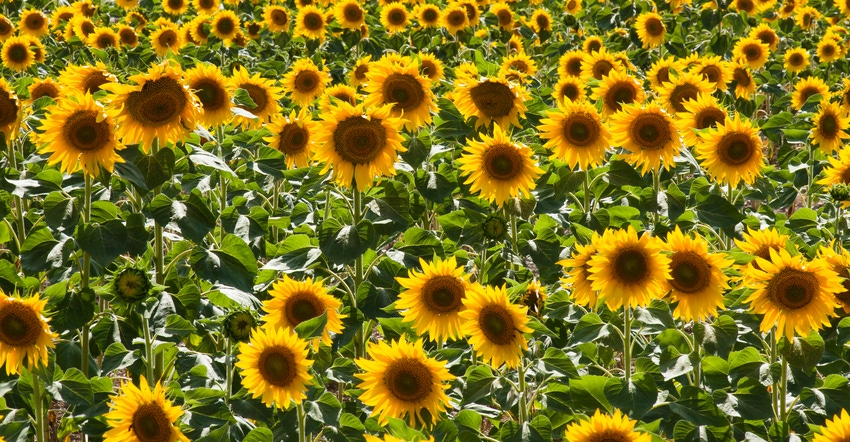
Total sunflower planted acreage is expected to be higher than farmers indicated in March, according to USDA.
Largely driven by increased oil-type sunflower acreage, total sunflower area is estimated to be 1.67 million acres, after accounting for 19,000 fewer acres of confection sunflower. A 31% increase in oil-type plantings accounts for 1.54 million acres of the higher acreage total, with increases in North and South Dakota leading the way.
Farmers in five of the eight major sunflower-producing states increased acreage by 25% or more. USDA estimates total 2022-23 sunflower production at 2.77 billion pounds, which would represent an increase of 46% from last year’s drought-reduced production.
Given the increased supply of oil-type sunflower, USDA anticipates 2022-23 crush volumes and sunflower oil production to increase appreciably. The extra supply of sunflower oil is expected to be consumed domestically.
The majority of the sunflower crop has been rated in the good to excellent categories in Minnesota, North Dakota and South Dakota throughout the growing season. This should mean that yields will be above trend, assuming normal weather through the rest of this fall and the lack of an early freeze. The exception to this has been Colorado and Kansas, where drought has most of the crop rated in fair condition, and yields will likely be impacted.
Overall, most market analysts are expecting U.S. sunflower yields to be above the five-year average this year. USDA will provide its updated yield and production estimates for sunflowers in October.
Increased seed production
USDA increased global sunflower seed production for 2022-23 by 1.16 million metric tons to 50.38 MMT, due to higher production in Russia and the United States. In Russia, farmers planted more sunflower than anticipated. Traders will be watching this region closely during harvest, as Russia is the second-largest sunflower producer in the world. Ukrainian sunflower production estimates remain murky due to the ongoing war but are anticipated to be around 40% lower than 2021.
With the higher global seed supply, the 2022-23 global sunflower crush is forecasted to reach 46.7 MMT on higher crush volumes in Russia and the United States, slightly above the 2021-22 marketing year. Global sunflower oil production is expected to be 19.61 MMT. Despite the higher global supply of sunflower oil, global sunflower oil stocks are projected to be relatively low at 2.1 MMT by the end of September 2023.
Oil exports to China, India and many other countries are expected to rebound from reduced levels experienced in the 2021-22 marketing year to more normal quantities. This is good news for high oil-bearing crops such as sunflower. U.S. sunflower oil export supplies have tightened recently and will only improve when new-crop supplies start moving to the crush plants in the coming months.
In preparation for harvest, producers are cleaning out storage bins, and deliveries to crush plants have been on the increase. This along with new crop deliveries could pressure prices in the near term. To keep up with price movement, visit sunflowernsa.com, or follow on Twitter @NatlSunflower.
Sandbakken is the executive director of the National Sunflower Association and writes from Mandan, N.D.
Read more about:
SunflowersAbout the Author(s)
You May Also Like






